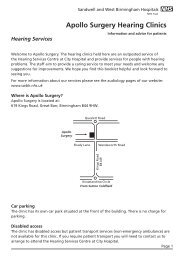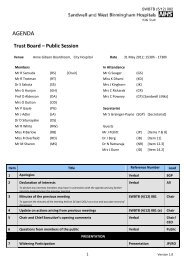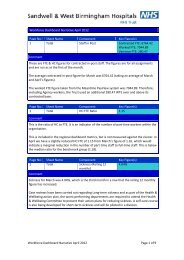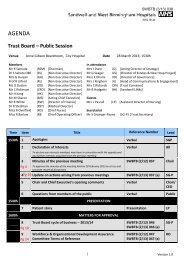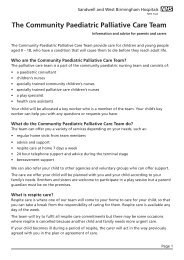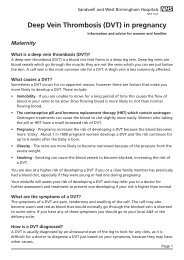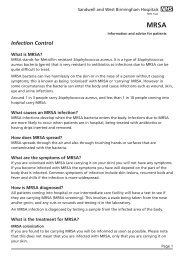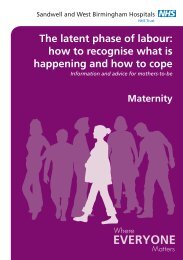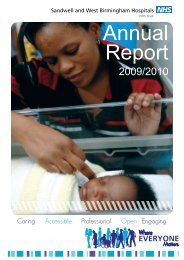Trust Board Febuary 2010 - Sandwell & West Birmingham Hospitals
Trust Board Febuary 2010 - Sandwell & West Birmingham Hospitals
Trust Board Febuary 2010 - Sandwell & West Birmingham Hospitals
You also want an ePaper? Increase the reach of your titles
YUMPU automatically turns print PDFs into web optimized ePapers that Google loves.
SWBTB (2/10) 045 (a)<br />
These efforts have produced good results with clear improvements in the <strong>Trust</strong>’s maternity services but<br />
there remain continuing concerns about medium term sustainability, particularly in respect of the<br />
Consultant led component of the service. It is these concerns along with the need to plan a transition to<br />
the new service model outlined for the new Acute Hospital under the Right Care Right Here Programme<br />
that led to the medium term review.<br />
As one of the first steps in the Medium Term Review of Maternity Services a report was produced in<br />
June 2009 that set out the clinical case for change. This report identified a number of drivers for change<br />
to the intra-partum and acute consultant led elements of the <strong>Trust</strong>’s maternity services. In summary<br />
these included:<br />
• New and increasingly challenging national standards.<br />
• The need to ensure that the actions which have been taken to improve quality and safety are<br />
sustainable in the medium term.<br />
• Given national staffing shortages, the need to attract and retain high calibre staff (obstetric and<br />
midwifery).<br />
• The increasing complexity of the population the <strong>Trust</strong> serves, with a rising birth rate.<br />
• The need to move towards the long term plan for the <strong>Trust</strong>’s maternity services.<br />
The clinical case for change concluded that from a clinical perspective a further change in the<br />
configuration of services is required in order to enable the continued promotion of normality for women<br />
with low risk factors and also the strengthening and further development of acute services for high risk<br />
women in line with the drivers for change. The consolidation of obstetric-led, high risk deliveries and<br />
associated acute care on one site would facilitate further improvements more rapidly (e.g. extended<br />
consultant cover for labour ward) than trying to achieve this on two sites and would also more robustly<br />
ensure the improvements would be sustained in the medium term particularly in relation to clinical<br />
leadership and presence. In addition such consolidation would ensure integration of staff from the two<br />
sites into one team working to the same clinical policies and processes ahead of the opening of the new<br />
Acute Hospital. This clinical case for change was approved by the Chief Executives of the <strong>Trust</strong>,<br />
<strong>Sandwell</strong> PCT and Heart of <strong>Birmingham</strong> teaching PCT.<br />
In accordance with national guidance, as set out in Changing for the Better (DoH 2008), the focus of the<br />
review has been on improving the quality of services. The Department of Health also requires that all<br />
new reconfiguration proposals (since 1st April 2008) are subject to initial clinical assurance provided by<br />
the National Clinical Advisory Team (NCAT). The purpose of the NCAT is to provide a pool of clinical<br />
experts to support, advise and guide the local NHS on local service reconfiguration proposals to ensure<br />
safe, effective and accessible services for patients.<br />
In line with this requirement a visit by NCAT took place in July to review the clinical case for change for<br />
the medium term service review of maternity services. The conclusion from this visit was support for the<br />
clinical case for change with the following recommendations:<br />
• Plan to transfer all high risk maternity services to one consultant unit at the City Hospital.<br />
• Set up job swaps to break down barriers and encourage consistency of approach.<br />
• Develop MLU at City Hospital.<br />
• Consider developing MLU within <strong>Sandwell</strong> if and when sufficient midwifery staff have been<br />
trained and/or recruited.<br />
• In the interim introduce a community midwifery team in <strong>Sandwell</strong> to test acceptability with users<br />
and build up midwifery capacity.<br />
• Consider retaining some consultant ante natal care in <strong>Sandwell</strong> to minimise the need for women<br />
to travel.<br />
• Consider re alignment and reconfiguration of gynaecological services between <strong>Sandwell</strong> and<br />
City to maximise on efficient delivery of care being cognisant of on call requirements and<br />
training issues.<br />
• Develop strategic plan centred on Community communication for proposed plans to enable<br />
community and political support for these moves.<br />
9




